WARNING: 4600+ words of awesome adventure
Traveling with me can be fun and excruciating at the same time. Due to my spur of the moment travel planning and non-existent organizational skills, I managed to botch the full circuit trek in Torres Del Paine, Patagonia with my friend Ken.
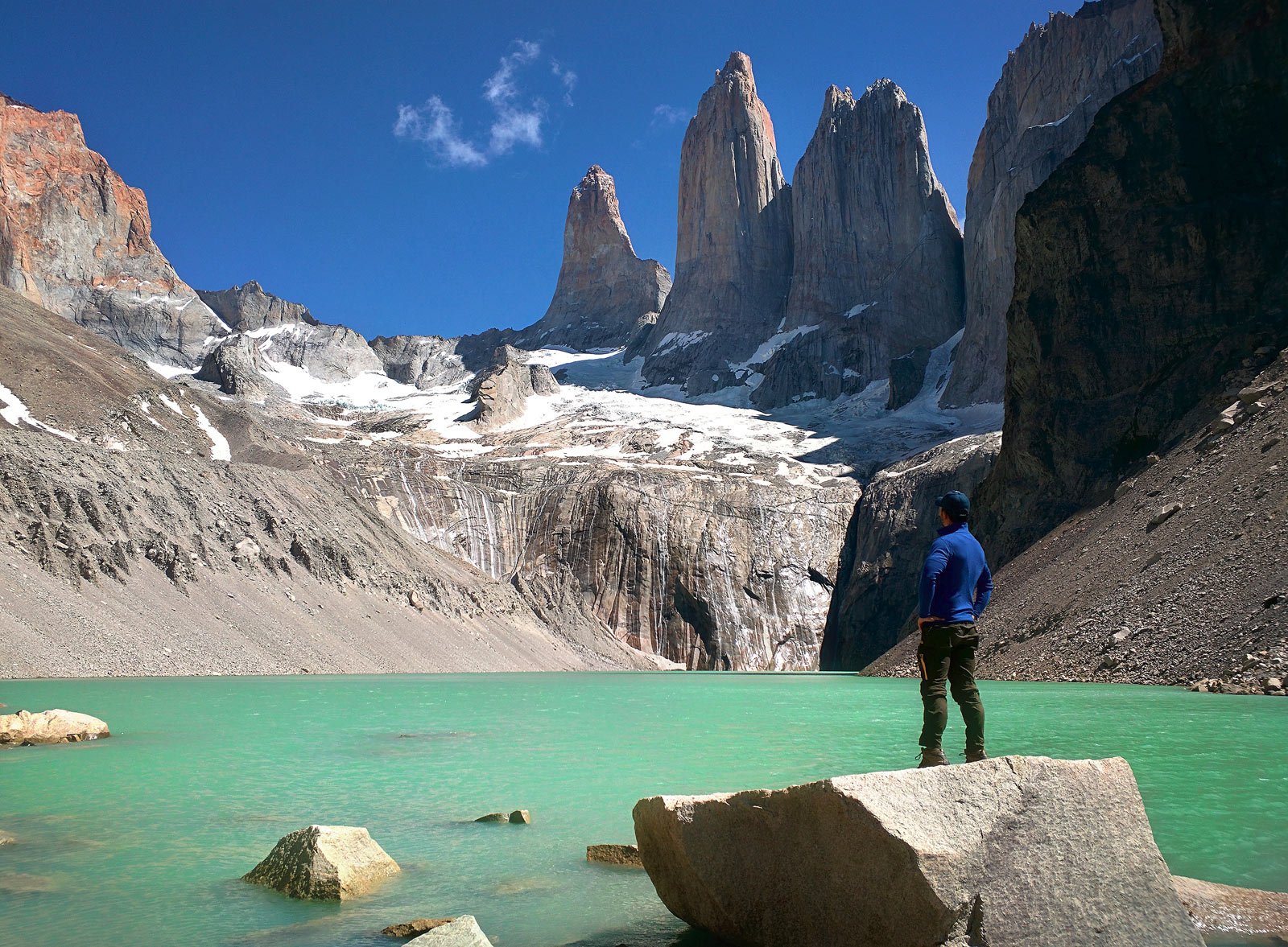
Torres del Paine's three towers.
Torres del Paine has long dominated the top of my South America adventure bucket list. I’ve dreamed of exploring Patagonia after seeing amazing photographs in various travel magazines and editorials. The most popular route people take is the “W” route, which highlights some of the astonishing attraction. I wasn’t going to do a cliff-notes version of the trek ("W"), I would do the full circuit, otherwise called the “O” or “Q” circuit.
Whereas the “W” trek highlights the best of Torres del Paine and can be done in 3-5 days, the “Q” circuit includes all the “W” route (58 km) plus an extended tour of the back side of the Cordillera del Paine. If you have great planning skills (unlike me) you would have booked campsites or Refugio (hostels) in advance to make the trek easy most people just peruse the Refugio to forgo carrying tents and sleeping bags.
Should have studied the map
As you can see from the map below, dashed in blue, the "Q" or "O" circuit resembles an O and includes the "W" trek, map download HERE. The more common “W” trek has the waypoints marked by a red star, you can see where it gets its moniker from, it forms a W in the map. Most people do the classic “W” trek counter-clockwise, starting from west to east.
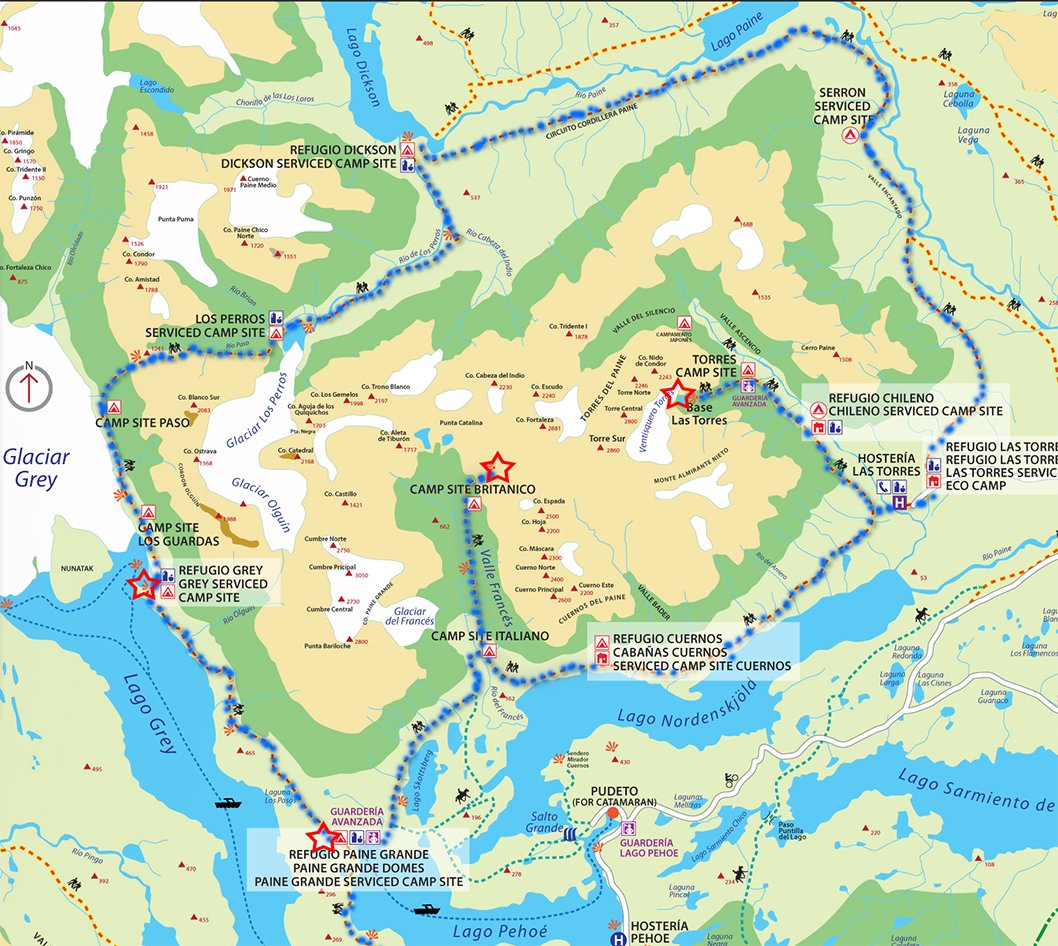
Torres Del Paine Q Circuit
Bring your own gear
Being seasoned backpackers, we have most of the gear needed for an extended stay in the backcountry so we opted to stay in campsites. If you don’t have the gear you can rent it from the jumping point at Puerto Natales on the Chilean side or EL Calafate in the Argentinian side. Be warned, paying $1 a day for a spoon will leave you scratching your head in amazement or banging it on a tree out of stupidity. Bring your own utensils if you can or any necessary gear if you have it.
There are few “free” campsites in the circuit ran by the CONAF and several paid campsites operated by two companies: FantásticoSur Lodges, +56-(61)-614 184 and Vertice Patagonia, +56 (61) 41-2742. You can book the Refugio and campsites in advance. You can even book your meals so you don’t have to lug around tons of food in the trail, but that’s for all you lazy people out there; true trekkers carry their freeze-dried nuts and ramen into the backcountry!
The paid campsites cost between $12 to $20 a night with basic toilettes and showers in the vicinity, I find the campsites here has better infrastructure than most campsites in California. If you bring your own tent, be sure it’s sturdy. Torres Del Paine is the windiest place I’ve ever been to and we’re talking random 100 mph gale force winds. It’s so windy it could blow away Donald Trump’s toupee and send him running after it faster than he’s running away from the presidential debate.
Other words of wisdom learned from my mistakes
Bring waterproof jacket and pants for the random rain that will surely fall. It’s freezing and windy! I got sick on the third day on the trail due the cold wind and rain, do not make the same mistake! Umbrellas and plastic raincoats are useless. Again, it’s very windy, you need attire that won’t flap around the crazy winds. Do your shopping for food before you get to El Calafate or Puerto Natales, the choices are limited and a lot more expensive; If you’re coming from Santiago do your shopping there. Hold your tripod and brace your camera, I repeat, it’s very windy!
I took my eyes off from my tripod mounted DSLR and swoosh, the f*cking wind ended its life and left me almost crying like a baby – that was a $2500 mistake! Nikon D800e’s don’t grow on trees you know. I ended up taking photos with my Android Phone and my GoPro the rest of the trip.
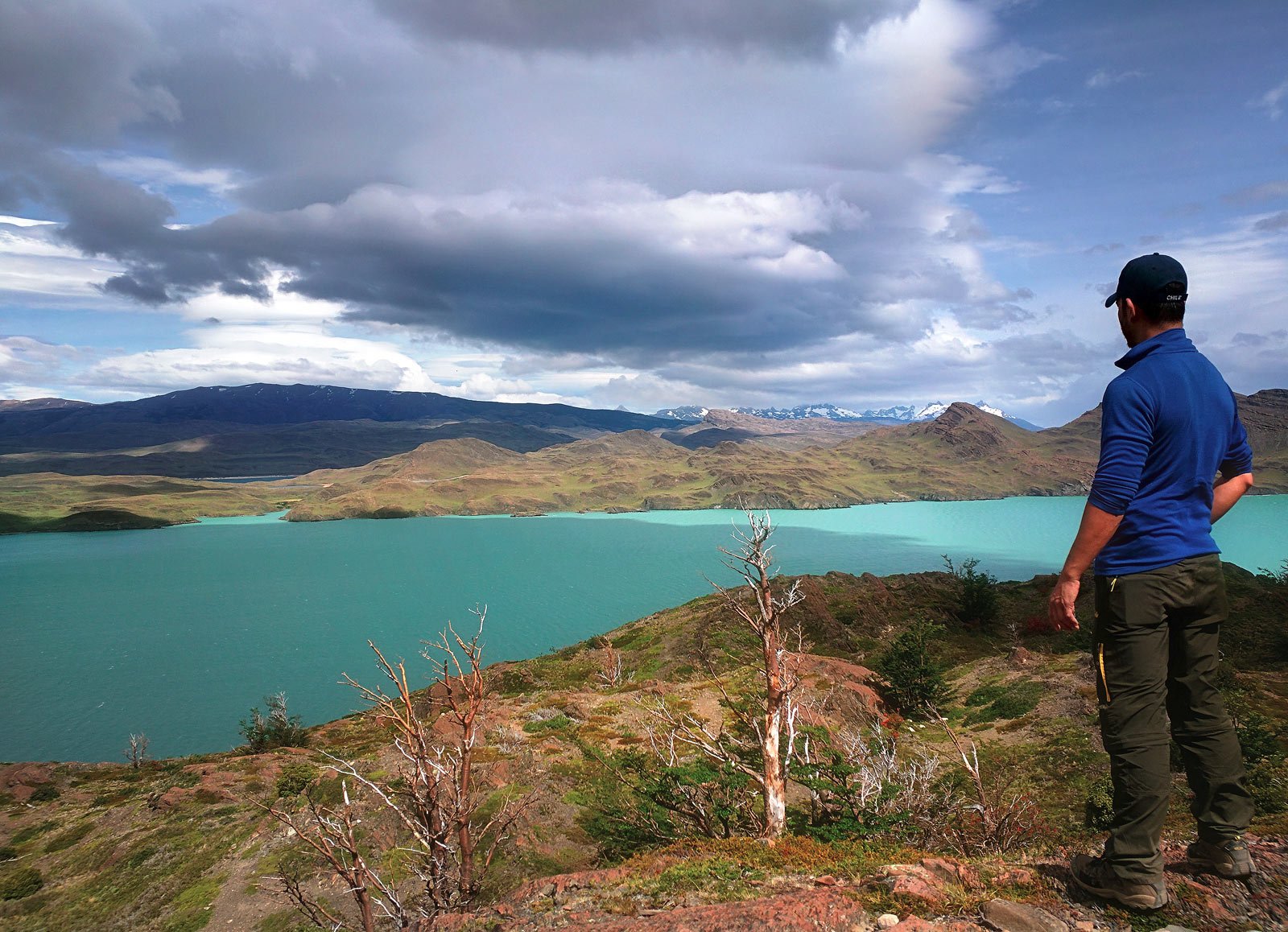
A smartphone still produced a usable image.
If you're trekking the "W" I would recommend going the opposite way, clockwise, east to west
Three reasons: One, by far the best attraction of TdP is the Las Torres. You want to see this on a sunny day and with TdP’s weather being too variable, you want to have leeway if you get caught in bad weather. Two, the view to Glacier Grey isn’t that impressive, you’re better off visiting the Perito Moreno glacier in the Argentinian Patagonia which offers the most epic view of a glacier on land (it’s a must see!). Three, the west side of TdP is wetter and windier and you’d want to tackle that last.
You’d think I’d follow my advice and just look at the map to plan my trek but no. Due to unforeseen circumstances, and due to my stupidity, we did a weird "U" trek instead of the traditional “Q” trek or “W” trek. We took a catamaran and completed one-half of the “W” then took the bus back to catch the catamaran again and completed the other half. Yeah, terrible planning on my part.
Ken and I booked a round-trip flight in advance from Santiago to Punta Arenas via LAN/TAM airlines, it was cheap at around $250. We didn't book a hostel in advance so we had to scramble and find one. There were also no buses running late from the airport into town we had to find an alternative transport to get there. A jovial dude approached us and said he had a taxi, we followed him to his car and he drove. Ken asked if there’s something wrong with his meter to which the driver responded if we wanted the meter on.
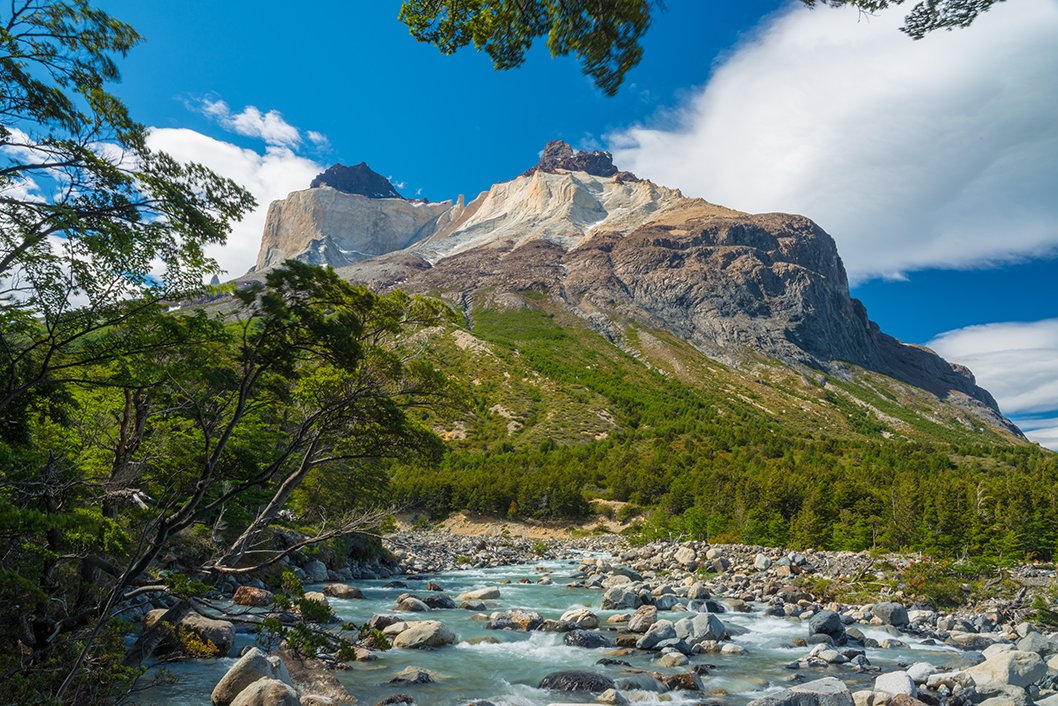
Las Cuernos Looming Over Rio Del Frances
Taxi scam?
Ken is a paranoid skeptic. I’m sure he’s read somewhere on the interwebs about the taxi scams that aren’t true taxi but private peeps who are out to rob and scam you of your precious dollars. The common advice is to make sure it’s legit taxis with legit signs. Negotiate the fare in advance. Make sure it’s metered. Our taxi driver asked if we wanted the meter turned on! But more important than the crap you hear online is, use common sense. If it doesn’t feel right don’t go through with it. Chile is very much a safe country and wealthy compared to say, Peru and Bolivia where scams and swindlers are rampant.
We paid around $10 for the taxi fare, which is about right for the 45-minute drive to our hostel. Speaking of the hostel, we got a freebie stay because they double booked our reservation, the only caveat is that one of us will sleep on the couch…I volunteered, seeing as I was the most seasoned couchsurfer.
Several buses are bound for Puerto Natales from Punta Arenas. It takes about 5 hours and it is very scenic. I don’t think I’ve ever seen a sunset that far south of the pole. The sunset on the west horizon lit the eastern horizon with rays. Amazing.
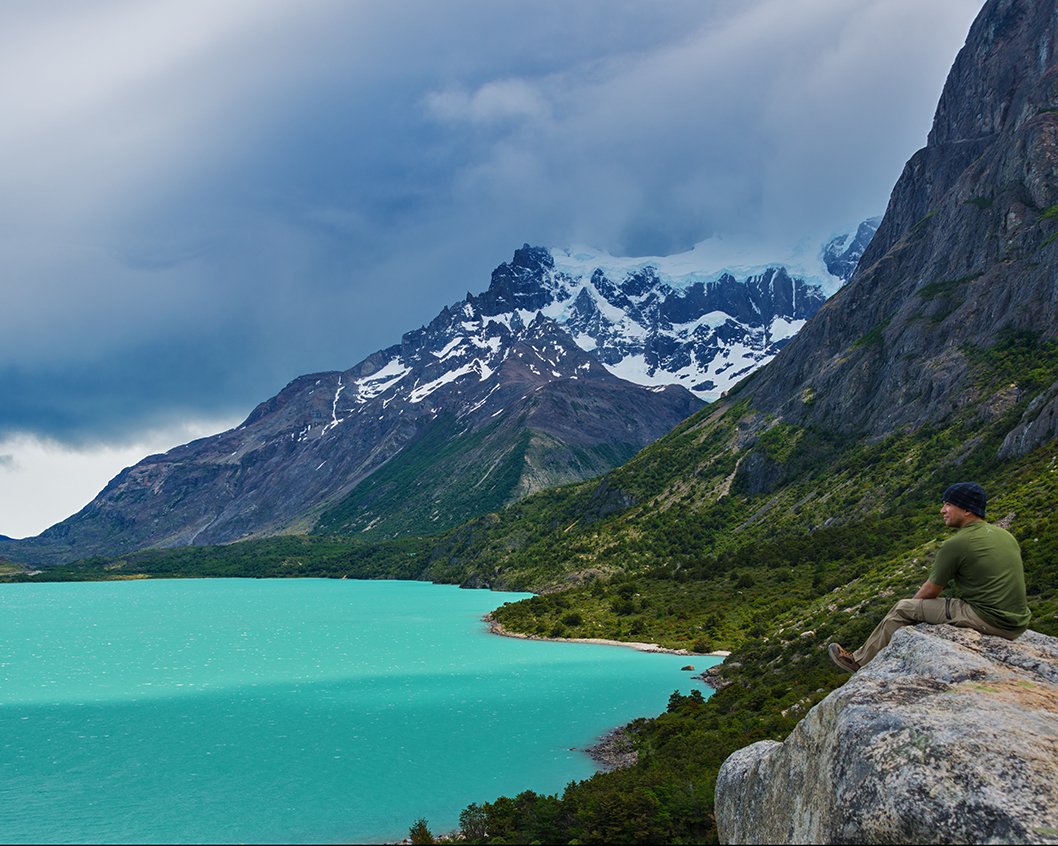
Ken enjoying the view of Lago Nordenskjold with Glaciar Frances looming in the backdrop.
We arrived at Puerto Natales in the afternoon with plenty of time to prep for our trek the next day and explore the town. Puerto Natales is a sleepy little town that’s catering to the tourist who visits the Torres Del Paine. There’s plenty of bed and breakfast hostels and westernized restaurants offering from Pizza to hamburgers.
Not so good food
Part of the focus on my travels is indulging myself in various cuisines of the countries I visit, but I’m disappointed in Chilean cuisine. It seems plain no matter what we try, even staples like burgers and pizza are lacking. I can’t quite put my finger on it, maybe it’s the lack of seasoning? Lack of imagination? I don’t know. Out of everything I tried in Chile, the Paila Marina is the only one that impressed. It’s a traditional savory seafood stew with various shellfish and fish seasoned with various herbs and spices. I recommend eating this over their Lomitos and Empanadas.
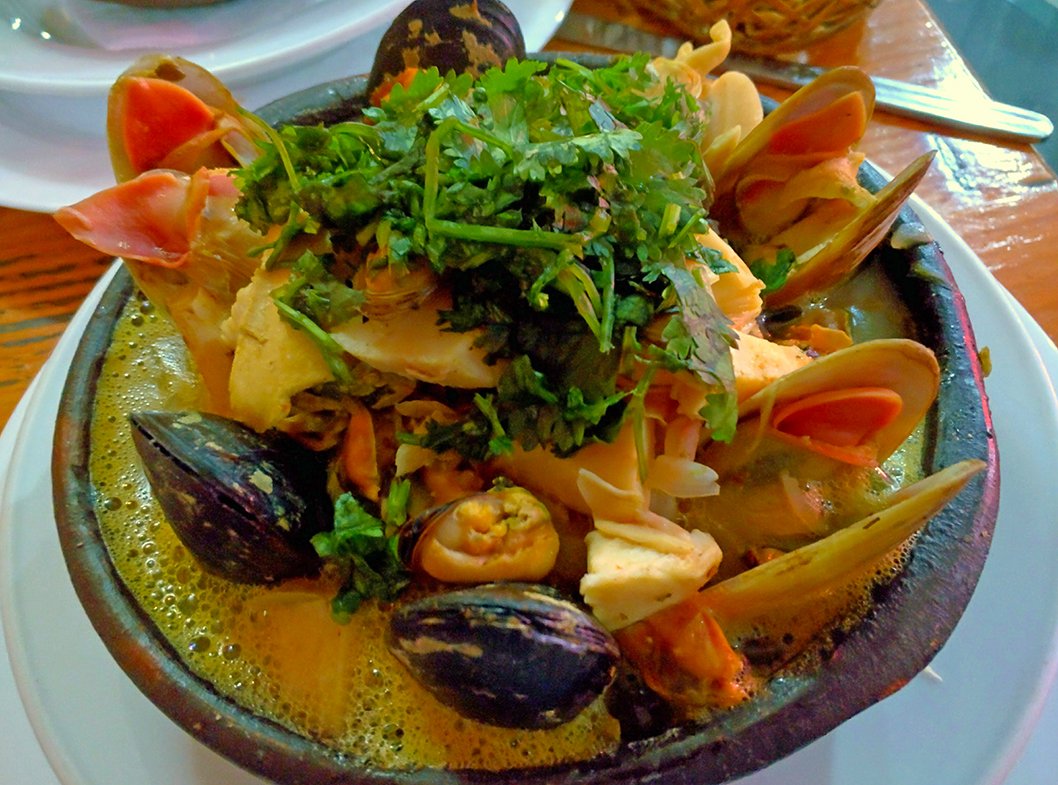
Delicious Paila Marina
As mentioned, we carried most of our backpacking gear except for pots, pans, and utensils. We rented the missing items at Erratic Rock, most people go this route so they don’t have to lug around heavy equipment all over South America. I’ve never had to rent pots and utensils before and I don’t think I ever will again, it’s not cheap!
One more thing before moving on to day one. Bring American dollars! They love it in South America, trust me. Don't use the ATM. Do shopping at various exchanges (Cambios) as they will often have different exchange rates.
DAY ONE: PAINE GRANDE TO CAMPSITE ITALIANO
Ken and I woke up early to catch the bus from the Puerto Natales terminal in Avenida España 01455 towards Torres Del Paine. Starting from October to April, several buses run regular daily trips (one in the morning and one in the afternoon) from Puerto Natales to the Park, it's cheaper if you buy a roundtrip ticket but don't lose the stub; I lost mine during the trek and had to pay another fare.
Puerto Natales is about a two-hour bus ride from Torres del Paine National Park. Puerto Natales is the common jump point for the most travelers visiting the park but you could stay on the Argentinian side at Calafate. However, it's further away and the road is bumpy. The bus ride was pleasant and I saw some amazing flora and fauna along the way such as the wild Guanacos.
Bus Stop
The first stop for the bus is at the Laguna Amarga ranger station where we got a 5-minute orientation (about the dangers of fire). This also where you buy a park entrance ticket. After the orientation, you will have to get back on the bus towards the second stop, Pudeto, where you can take the catamaran across towards Refugio Paine Grande.
Most people trek the "W" starting from Refugio Paine Grande towards Glacier Grey, but not having done enough research, we ended going the other way towards Campsite Britanico, a free campsite serviced by the CONAF. You can see from the map below how I've planned the trek. I went to the right. In hindsight, I should have gone left :)
The catamaran cuts through Lago Pehoe, a beautiful aquamarine lake fed by glacial waters. The catamaran provides amazing views of the Salto Grande if you ride at the top. Be warned! It's windy, wet and cold to ride up there, but it's well worth it for the views!
For your reference here is the schedule and tariff prices for the Catamaran, it's cheaper to buy the round-trip ticket than one way. Speaking of purchases, bring a lot of cash! There're several places in the park that don't take credit cards and fewer still, ATM machines. We didn't carry enough cash and ran out of money to purchase a bus ticket back to Puerto Natales.
After getting off the catamaran, we prepped for the long hike ahead. My plan was to make it to campsite Britanico before nightfall. Things weren't looking very pleasant that day, the sun, obscured by dark foreboding clouds, won't produce a photogenic sunset (I came here for photography as well).
A breezy trail
The trail meanders in a northeastern direction, cutting through the Rio Del Frances. It funnels to the base of campsite Britanico which is a campsite used as a base by mountain climbers. This part of the trek is a leisurely walk. It snakes around the Paine Grande with varying views of the Cuernos and Lago Skottsberg with stops at Campsite Italiano.
The trail is well maintained, no crazy boulders and rocks to traverse over and little elevation gains. At the highest point, you can see snow-capped peaks and Lago Nordenskjold which would dominate the view of the trek towards the Las Torres.
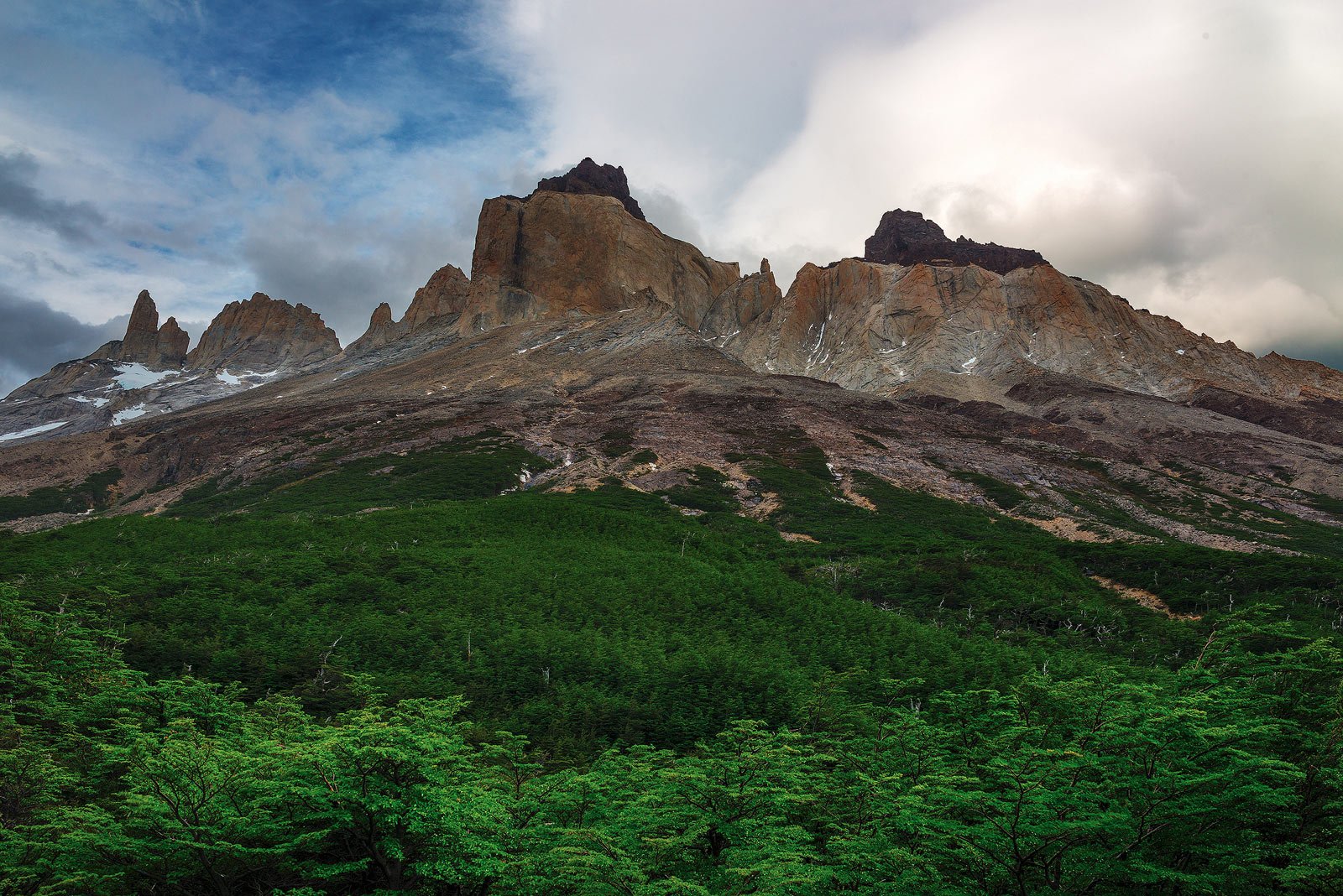
Cuernos del Paine. Patagonia is a mountainous area that spans Chile and Argentina
We zigzagged around Rio del Frances until reaching a bridge which offered a way to get across the raging rapids down below. Across the way is Campatamento Italiano, a free simple campsite with a ranger station operated by the CONAF. We took a break and I asked the ranger, with my broken Spanish, "Cuanto tiempo para caminar de campatamento Britanico?" To my joy, he responded with broken English, "Two hours but the camp is closed and only for climbers."
My lack of planning caught up. We had to change our plans again! We pitched our tents at campsite Italiano and then do the hike to Valle Frances.
After refilling our water bottles, Ken and I walked the trail, meeting tired hikers along the way which hinted at some steep inclines awaiting us. This part of the trek was moderate and maybe bordering on difficult as you trudge along giant boulders and crossing various rocky terrain, all the while competing against the unforgiving Patagonian winds.
We trekked along forest canopies, zig-zagging through creeks, and gaining elevation up the Cuernos. The trail opens up and you can see the majestic Los Cuernos del Paine rising 8,000 feet above Lago Nordenskjold. Cuernos means horns in Spanish and I can see why the peaks got its name. We finally made it to a vista point that provided amazing views of the Cuernos and Glacier Frances.
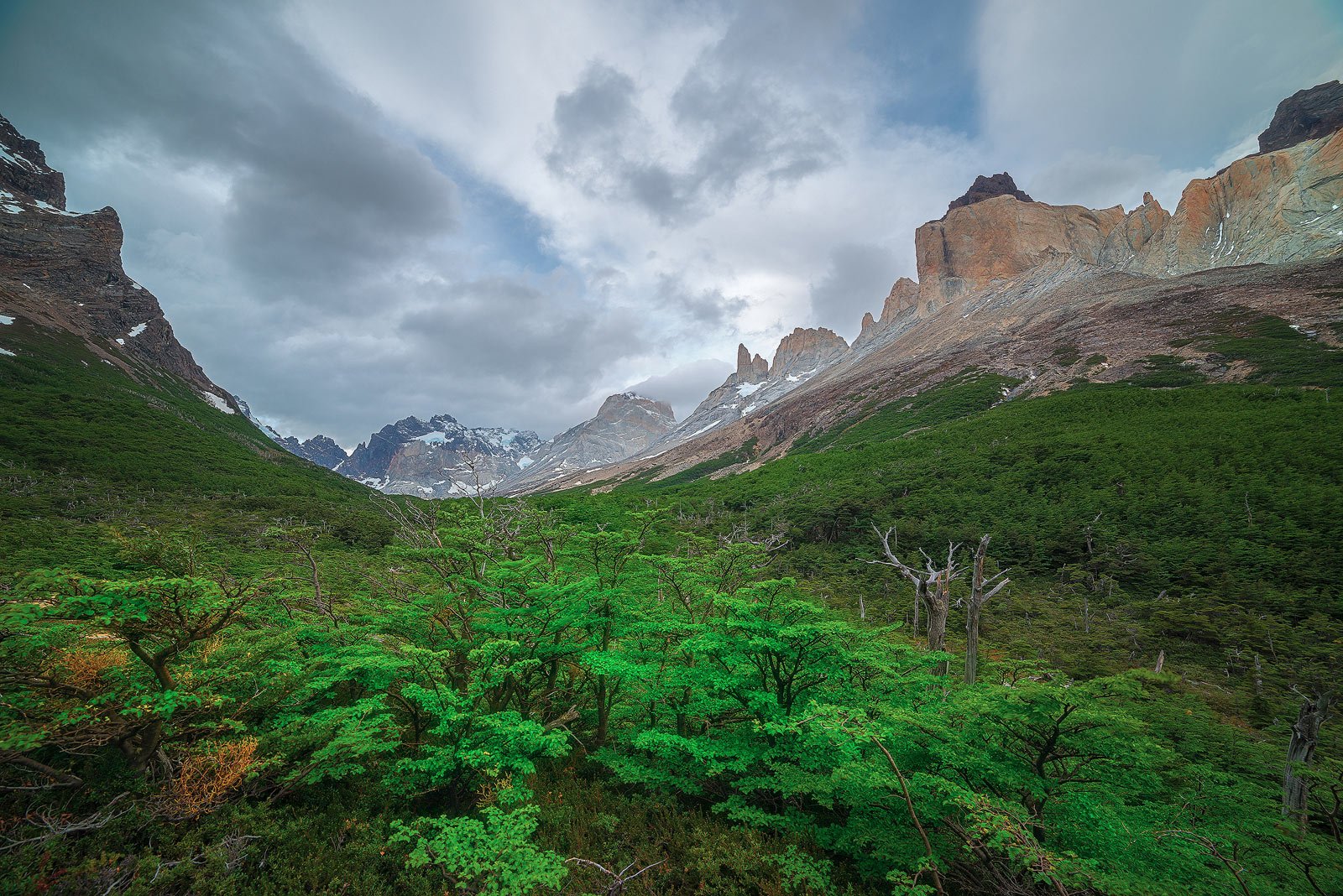
Windy day in Valle Frances, Torres Del Paine, Patagonia Chile.
From there, we got our first taste of the insane Patagonian winds. You could lean forward 45 degrees towards the wind and the flop over. We tried to take pictures and using a tripod proved to be an exercise in futility as gusts of wind would just topple it over.
We asked a hiker coming down from Britanico how much further it was. She said it was another two hours up the trail. I felt the wind slapping my face around like a loose undergarment so we decided not to do the rest of the trek; We headed back down to campsite Italiano where a hot warm soup of top ramen was waiting. (Use the Page Numbers below to navigate through the pages of this article)
DAY TWO: CAMPSITE ITALIANO TO REFUGIO LAS TORRES
We woke up early on the second day to the sound of howling winds. Luckily, there was a designated hut where you can use your portable stove to cook protected from the wind. We cooked and ate our breakfast, refilled our water containers at the Rio Del Frances (no water filter needed) and hiked towards Refugio Cuernos. The plan was to camp out at Refugio Cuernos for the night then head down to Refugio Las Torres the next day.
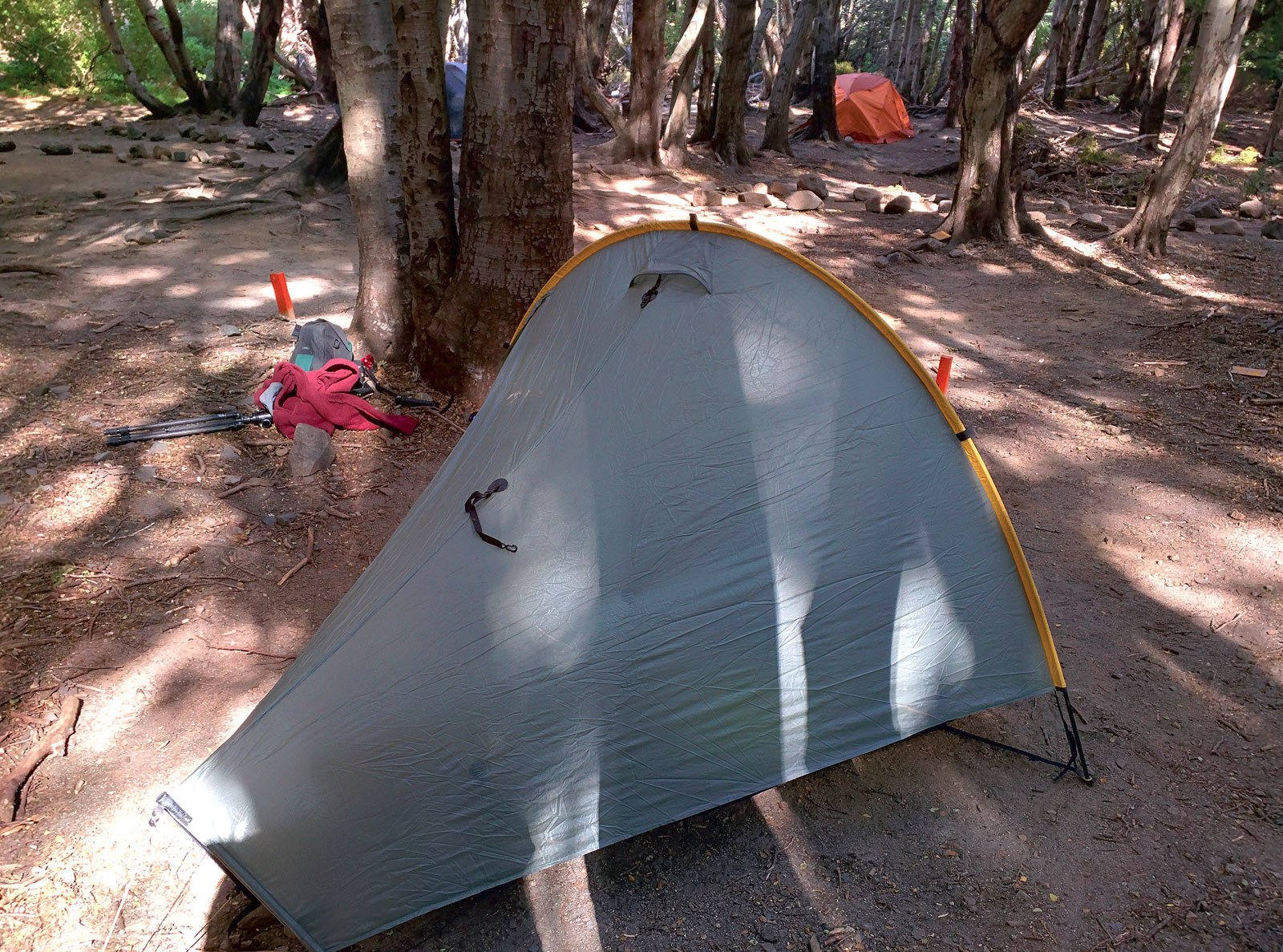
My trusty little tent in Patagonia
I booked the campsites in advance, which in hindsight wasn’t necessary. You can just show up at the campsite and secure a spot. The campsite, sandwiched between Cuernos Del Paine and Lago Nordenskjold, gives you views of the Cuernos and Lago Nordenskjold.
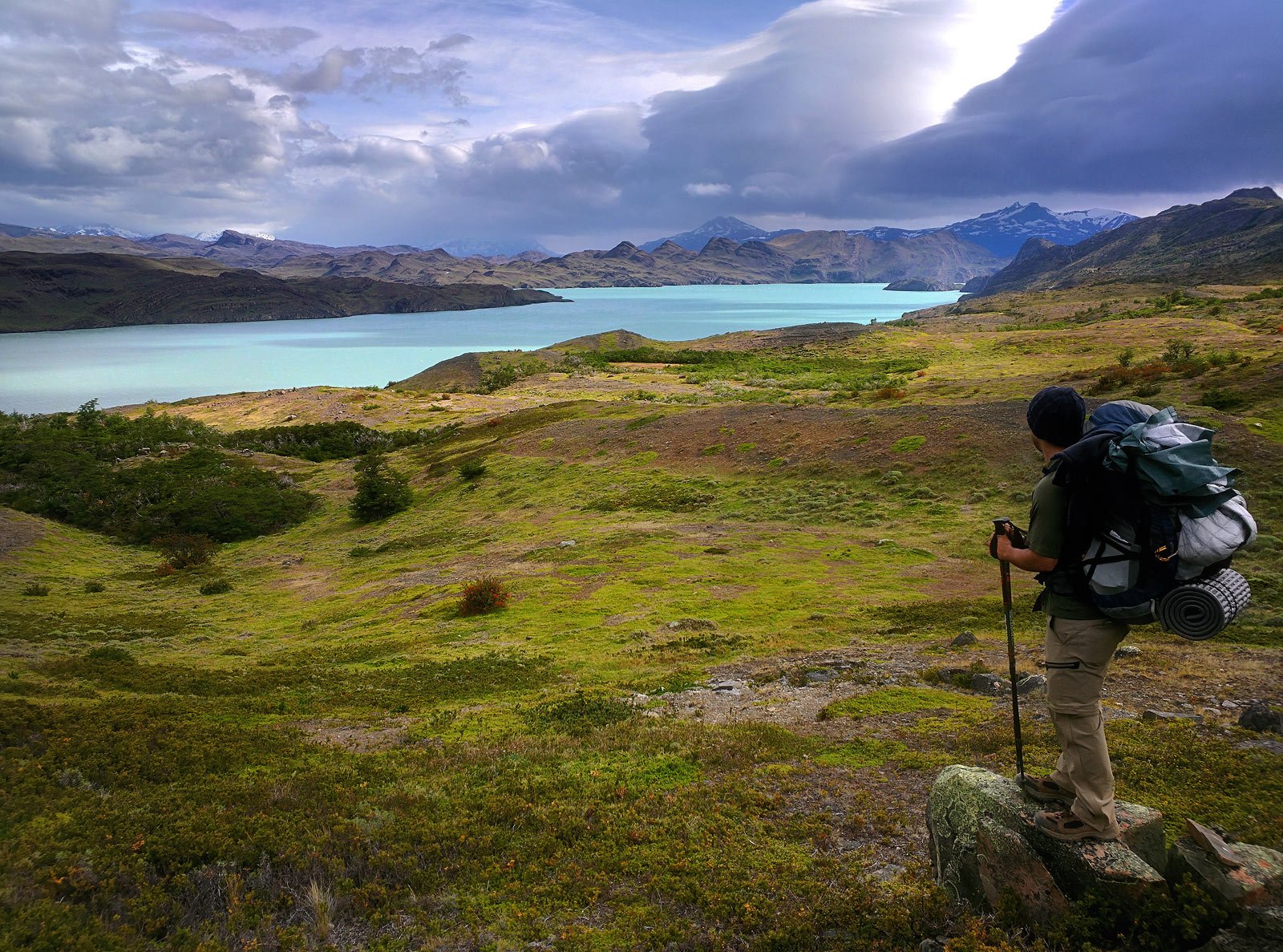
Lago Nordeskjold unfolds over the horizon in Torres del Paine
The glacial lakes are amazing
Even with the rain and the wind to impede our hike, we still arrived at Refugio Cuernos within 2 hours. We broke for lunch and I tried to fix the messed up campsite booking with the receptionist. There wasn't anything she could do, so we decided to just make our way to Camp Las Torres (we're a day behind the booking).
I composed the image in my head, used Ken as a subject in the grand vista. I set up my tripod, turned around for a second to direct Ken and SWOOSH! A gust of wind came like a tornado wreaking havoc as it fucked up my camera, my precious camera! It got KO'ed by a Mike Tyson punch.
"ERROR," it says. I pressed the shutter, no response.
The LCD was on, still bright, maybe it's still breathing. I tried to perform CPR but I didn't know where to begin. I turned it off and back on, nada. No response. It's Kaput. There on that fateful day, TdP claimed another victim. A Nikon D800e fell to the harsh Patagonian elements and I left the unnerving feeling of uncertainty. A photographer without a camera? There's another week into this trail, what am I going to shoot with?
I'm a practical pragmatist and I think human emotions like worry and panic accomplish nothing. I still had a GoPro and my phone (Google Nexus 6) which has a 16 Megapixel camera with an HDR+ capability. It's no substitute for a high powered DSLR like the Nikon but I've been able to get away with a few sunsets with it.

It's a capable phone." width="1600" height="1172" /> It's a capable phone.
Cameras are just tools, akin to a painter's paintbrush. It doesn't take pictures, cameras do! I wanted to prove this point true and will take pictures with just my phone and GoPro for the rest of the trip. I packed my broken camera and instead of feeling down from losing a three thousand dollar camera, I held my head up high with renewed zest to prove I can take decent pictures without an expensive camera. (Use the Page Numbers below to navigate through the pages of this article)
DAY THREE: CAMP TORRES TO LAS TORRES (THE TOWERS)
I should preface that day three in this trek includes part of day 2. The original plan was to camp out at Refugio Las Cuernos the night before but we overestimated the length and hiked all the way to Camp Las Torres instead. There weren't much to see in Refugio Las Cuernos anyways and no grand vistas nor any side country treks to tackle.
The Refugio, which looked like a hotel, offers private rooms and bunk beds. Located at the base of the peaks, the Las Cuernos campsites offer protection from the wind being surrounded by small trees and thickets. This place is legit.
There are shared shower rooms and toilets nearby and a small grocery store with a few necessities. They even offer meal vouchers you can purchase and get a meal at the Refugio, it's around $10-15 bucks. It's cheap by American standards but expensive by my travel standards; long-term travel can't last long with these sort of expenses. Speaking of not lasting long (ok no dirty jokes all right?), we were running low on cash due to my penchant for purchasing a lot of wine (according to Ken).
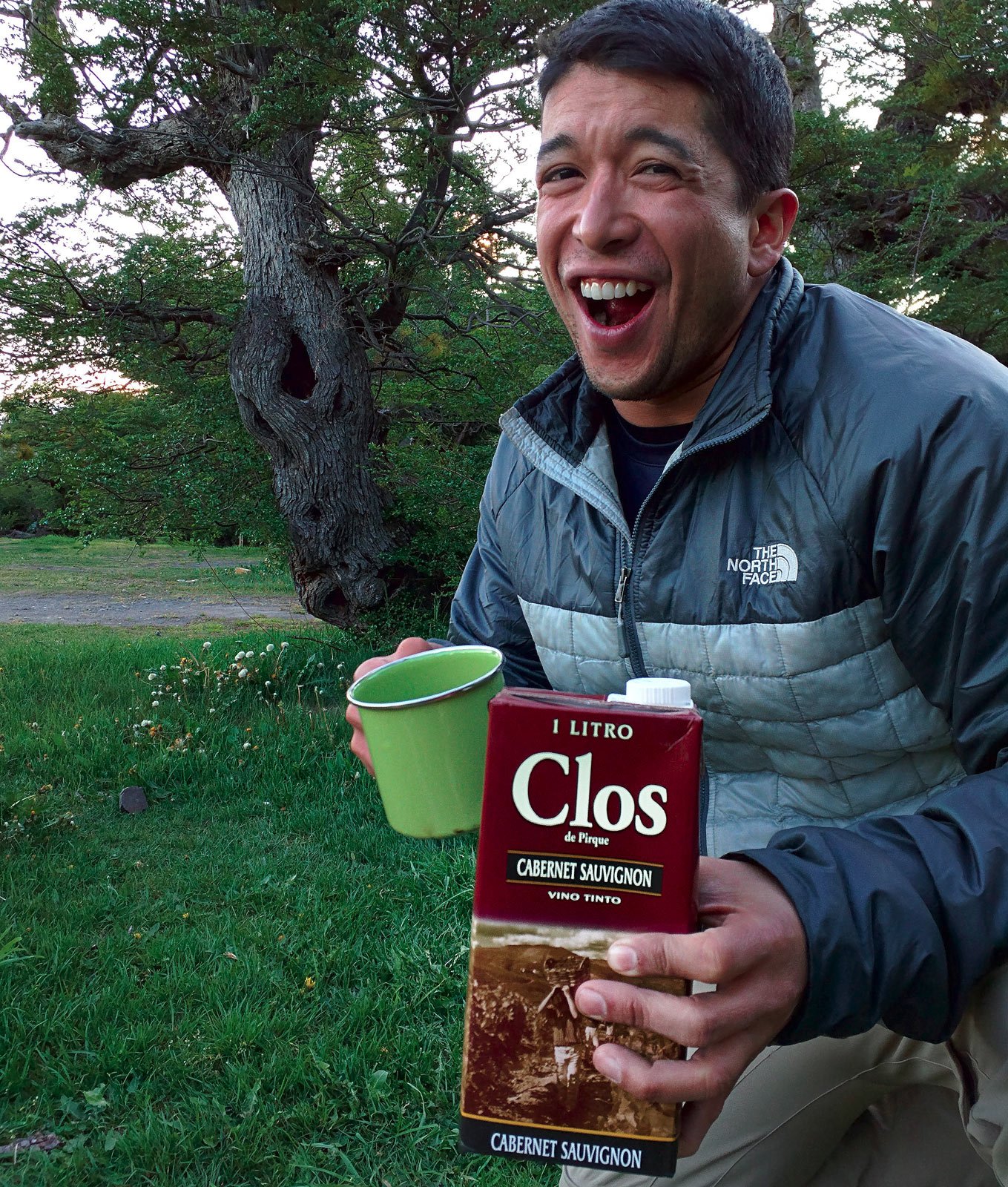
Ken approves. Wine is so good in Chile even the boxed ones rock!
Did I tell you that Chilean wine is magnificent? I mean magnificent! The food sucks in Chile but the wine is amazing! Even the boxed wines are killer, it was killing our cash reserves and most places on the trail including some of the Refugio do not have ATM machines nor do they take credit cards.
While we're in our campsite enjoying our delicious boxed wine, we heard a beautiful melody from a stringed instrument somewhere. We chased it down to the source which was a young woman named Anita. Anita works as a tour guide in the Las Torres part of TdP. We learned later from her that the trail on back-side closed due to high winds and weather; this would make the complete "O" circuit trek impossible. We would play it by ear and decide after we hike the to the Las Torres if want to complete the entire circuit.
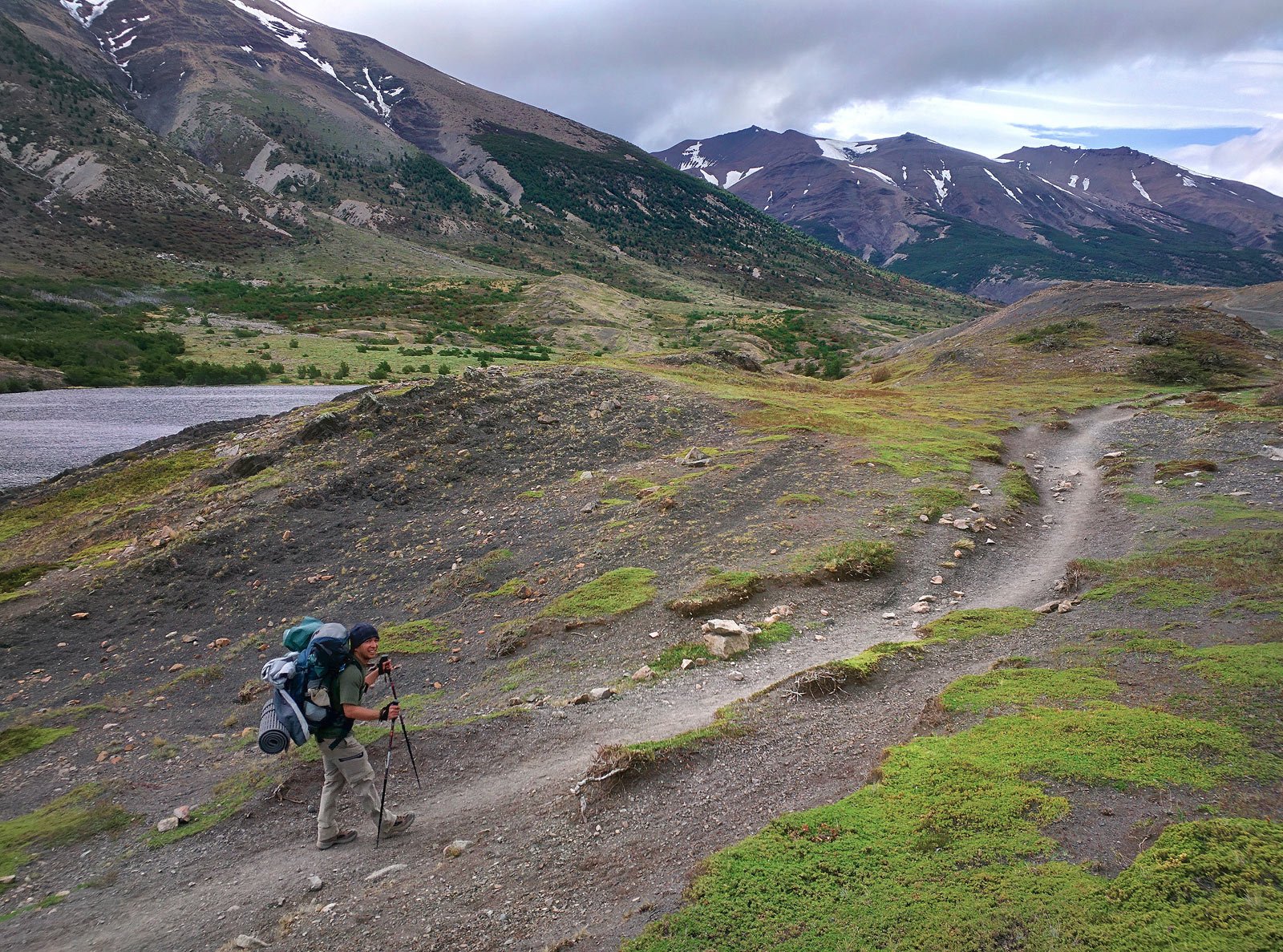
Torres Del Paine Trail
We shared our boxed wine with Anita and talked about the meaning of life and whatever else subject that come up when conversing with complete strangers in the wilderness. I mentioned I like to collect moments instead of things. Anita was in complete agreement. We talked about the how the rat race, pursuing material wealth, and the rampant consumerism is slowly killing America. Along with her soothing voice and melodies of strings, I thought to myself, finally, somebody who gets it!
Gets me!
As the night dragged on, fueled by red wine and music, I learned that Anita lives with her boyfriend who's also a tour guide. Ouch! I mean, good for her! Off to the cold dreary tent alone and rest up for the long day ahead. I woke the next day to a shaking and rustling tent. I poked my head outside to see what was going on. 'Twas the harsh Patagonia winds of course!
But there at the corner of my eye, I caught a glimpse of something very beautiful. Above the clouds and my over our campground is a double rainbow. I'm suddenly awoken with a renewed zest. I would capture this moment with a camera. Man, I wished I still had my DSLR to capture this moment!
Unfortunately, charging units are few and my phone is practically dead. Luckily, I had juice left in my GoPro. I quickly donned my jacket and braved the cold winds to capture the rainbows.
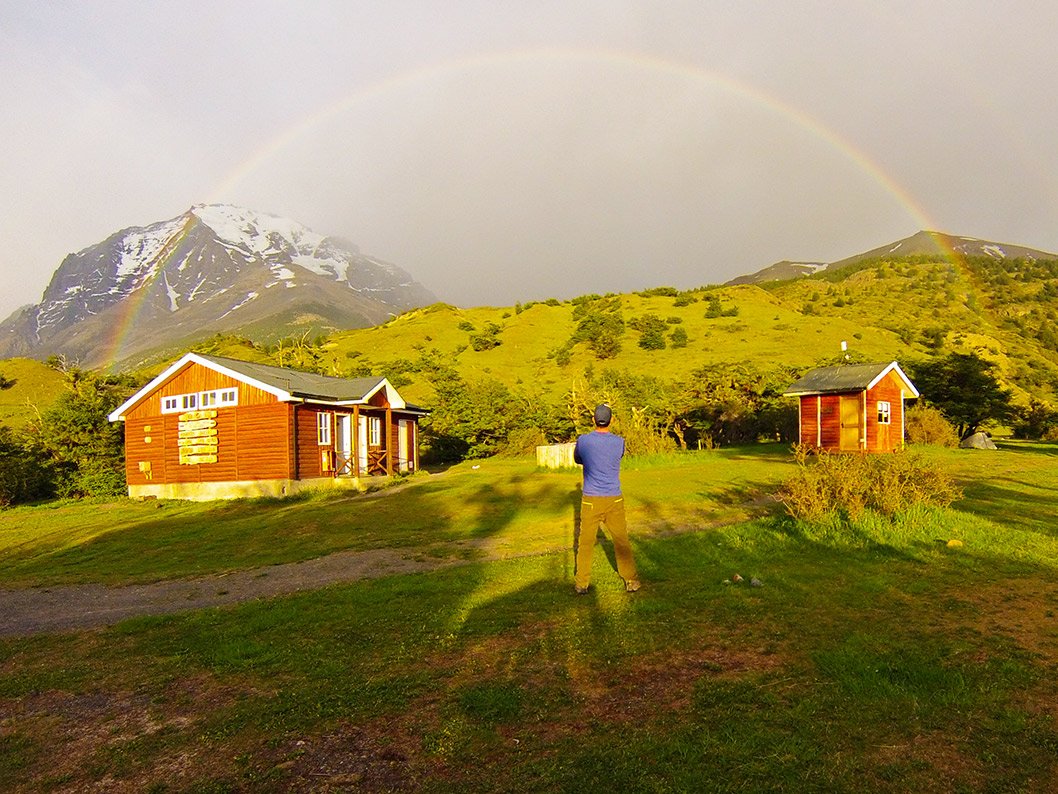
Under the rainbow
Rainbows!
After witnessing the beautiful rainbow we got breakfast at the Refugio and started the hike. The way ahead of us is a moderate hike the Rio Ascencio right under the eastern face of Torres Del Paine. The last hour of the hike is a knee bruising ascent with the constant scramble on boulders and loose rocks. It would have been a more difficult ascent if we carried our gear. I'm glad we left most of it in camp.
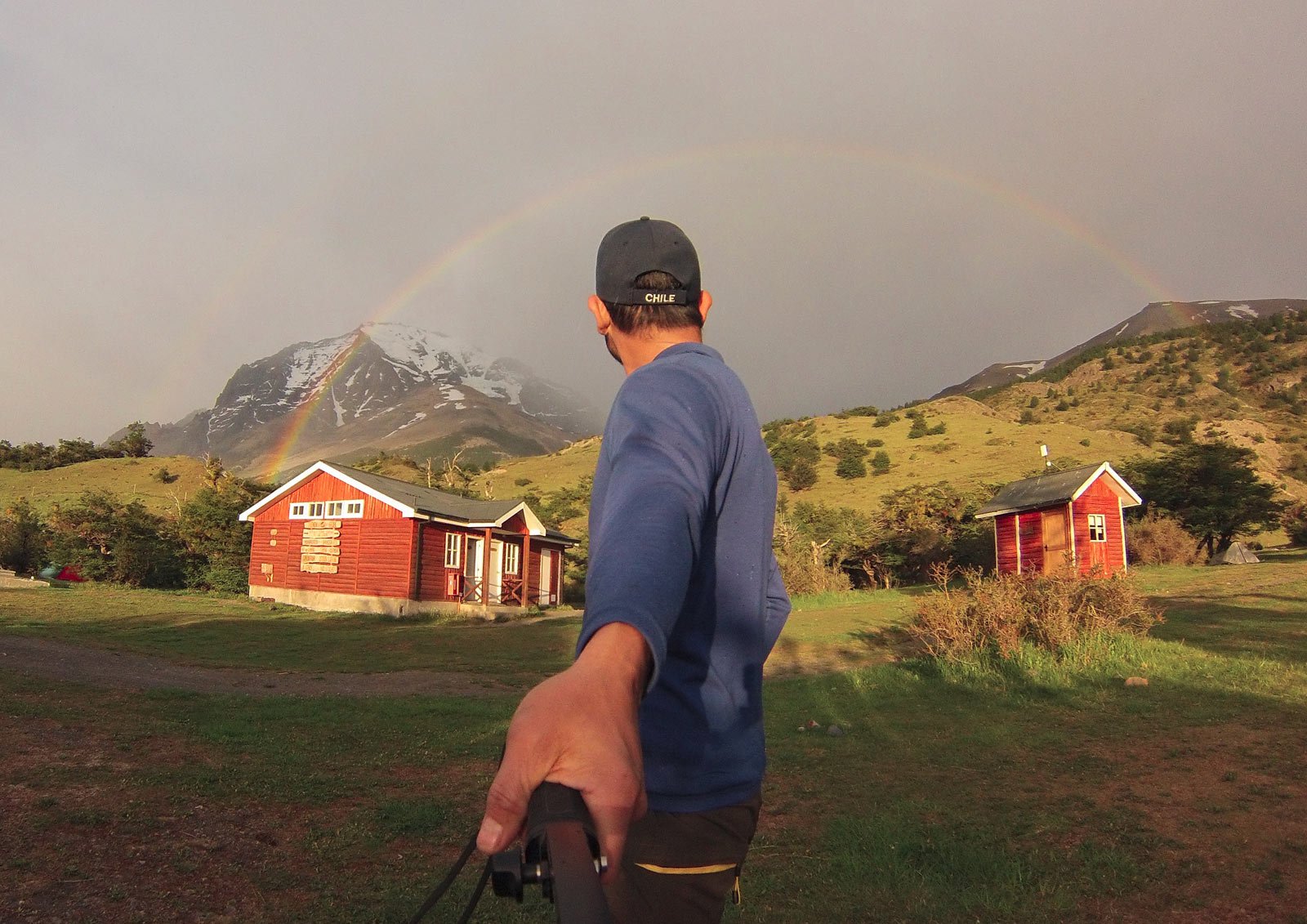
GoPro Rainbow Capture
We can see the towers slowly open up to blue skies over the horizon. In November, the weather is variable and if you're doing the "W" trek from east to west, you'll run the gamble of not getting a sunny view of the towers. If you're doing this hike I recommend giving yourself a day or two for the unforeseen variability of the weather. It would suck flying halfway around the world to get an awesome picture of the Torres del Paine only to be rewarded with dull skies.
DAY FOUR: THERE AND BACK AGAIN (REFUGIO GREY)
This should have been Day 1 on the trek but as mentioned, I botched the planning on this trip. We were going to hike to Camp Serron to continue on the circuit the next day but we heard that the trail was still covered in snow. We didn't bring any winter gear and didn’t we didn't want to take any chances. From talking to guides on the trail, the “W” has all the best views and that there weren’t many things interesting in the backside of the circuit.
We decided it was better to take the bus all the to the Laguna Amarga station and catch a connecting bus back to Pudeto. From there we would catch the Catamaran back to Paine Grande again. We were basically backtracking and breaking on the O circuit, hence the Botched "Q" circuit title.
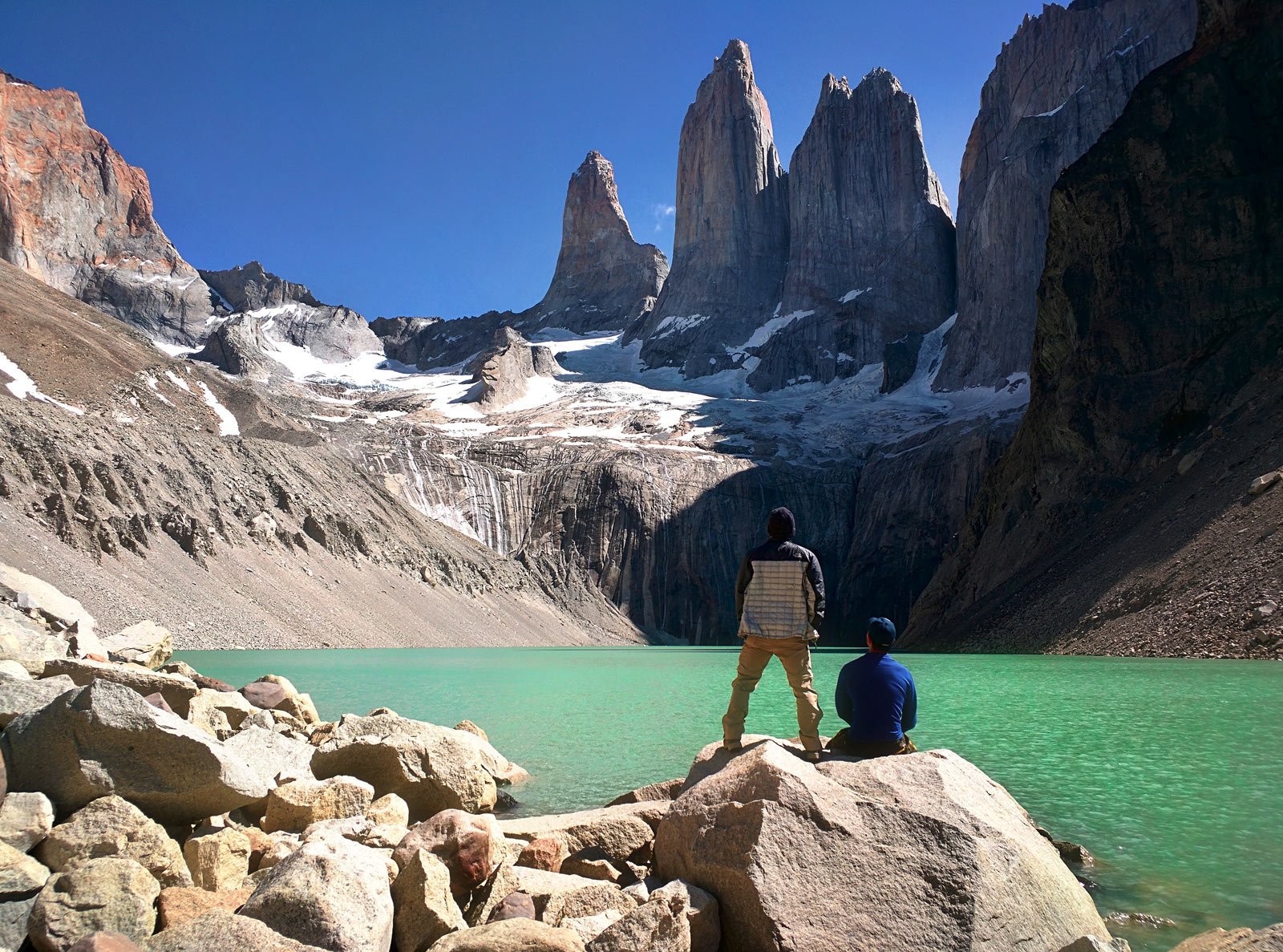
Views like this make it worth all the while in Torres del Paine
The normal way would have been to hike to Glacier Grey at the beginning and then head on to Valle Frances. From there continue on to complete the Trek toLas Torres. Not so in our case, a little backtracking and stupidity are how we roll.
Bring plenty of cash
To compound the issue, I was strapped for cash and I lost my round-trip ticket. The buses don’t take credit cards and the Catamaran don’t take credit cards. We calculated that after all the bus rides we wouldn’t have enough money for the Catamaran, I would have to swim across the lake. Luckily, Ken had some U.S. dollars left. They take dollars, thank god! I can’t stress it enough you bring plenty of cash. Bring American dollars.
The winds on this side of Torres Del Paine is stronger and colder. The trail starts off fairly flat, but about a mile up, it slowly winds its way into a steep hill. You can feel your knees pop at each step while being pushed back by the bone-chilling winds. It then meanders up a forest that runs parallel a lake, Lago Pato (Duck Lake).
There were no ducks on that lake. I just can't picture any tiny little ducks surviving up there. IT IS WINDY! You can practically lean your entire body forward 45 degrees and the force of the wind is strong enough to keep you from tipping over.
Cold and windy
The weather is much milder in mid-December through mid-January but the crowd of people is much more unbearable. So those of you doing this trek, pick your poison, gale force winds and cold rain or hiking shoulder to shoulder with tourists for miles on the trail. I can say, this part of Torres Del Paine is the most Paineful(pun intended) section of the “W” trek.
The trail opens to Lago Grey and you can see fragments of the glacier that have broken off from the main glacier. It’s quite a sight to behold and quite an experience to feel. I’ll never forget that blasting arctic wind threatening to turn my nose to a popsicle. I can’t stress this enough, for you doing the TdP in the shoulder seasons, bring waterproof pants, hiking shoes, and jacket! It will save you from a ton of misery.
Reached camp and managed to find a spot but by then it was already raining cats and dogs and we had to pitch our tents in the cold rain. The Refugio sure looks cozy at that moment. I thought about plunking a hundred dollars just take a respite from the raging rain. But we’re men, we are mountain men, and we will prevail.
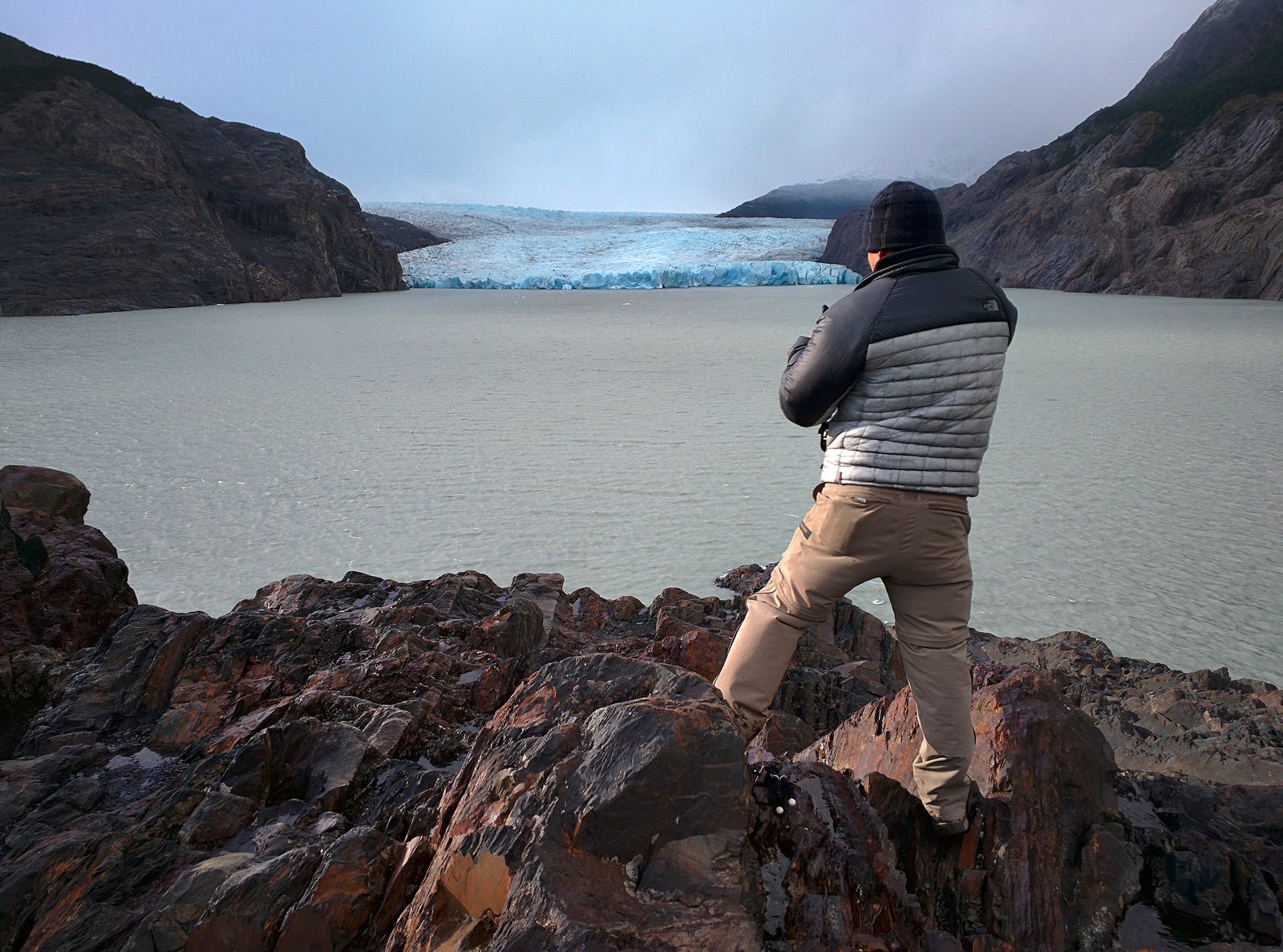
Ken taking pictures of Lago Grey
After setting up our tents, we did a quick hike to Glacier Grey to see if we could catch a sunset…No such luck, dark clouds have engulfed the entire skies so we took a few photos as best we could then made our way back to the campsite. We ingratiated ourselves with some booze at the mini store and brought our drinks over to the Refugio.
We did not sleep well
I woke up shivering and soaked in a damp and wet sleeping bag. It rained so much the night before some of the water found its way into my tent. Ken had already packed up his tent, no doubt trying to escape the cold rain as fast as he could. I packed my camping gear and rushed to meet Ken at the cabin.
My raincoat kept getting blown over by the fierce wind and the rain did the rest. We were to suffer this for another 4 or 5 hours before getting back to catch the catamaran. It is the freezing and wet reality we faced that day at Glacier Grey. I got sick from that final trek with a cold would torment me for the rest of my trip in South America but the experience from the trek was well worth it.
HAVE YOU TREKKED THE TORRES DEL PAINE CIRCUIT?

"Travel is fatal to prejudice, bigotry, and narrow-mindedness." - Mark Twain
All photos are taken and articles are written by Adonis Villanueva of Always Wanderlust unless otherwise stated.
USE YOUR SP TO EARN PASSIVE INCOME - SMARTSTEEM
GET MORE FOLLOWERS - Steem Engine
THE BEST TRAVEL CONTENT - TRAVELFEED
Have a Laugh!
The Spider in the Patio
Detained for Drugs in Norway
Unforgettable Ride on a Chicken Bus
The Love Valley
Twitter Page, AlwaysWanderlust
Facebook Page, AlwaysWanderlust
Instagram Page, AlwaysWanderlust
Website, AlwaysWanderlust.com
Join the Steemit Travellers on Discord
© 2017 AlwaysWanderlust.com All Rights Reserved
